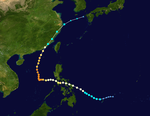2006 Pacific typhoon season
| 2006 Pacific typhoon season |

Season summary map
|
| Seasonal boundaries |
| First system formed |
January 20, 2006 |
| Last system dissipated |
December 20, 2006 |
| Strongest storm |
|
| Name |
Yagi |
| • Maximum winds |
195 km/h (120 mph)
(10-minute sustained) |
| • Lowest pressure |
910 hPa (mbar) |
|
| Seasonal statistics |
| Total depressions |
40 |
| Total storms |
23 official, 1 unofficial |
| Typhoons |
15 |
| Super typhoons |
6 (Unofficial)
|
| Total fatalities |
At least 3,886 |
| Total damage |
$14.4 billion (2006 USD) |
| Related articles |
|
|
Pacific typhoon seasons
2004, 2005, 2006, 2007, 2008
|
| Tropical depression (JMA) |
|
|
| Duration |
January 20 – January 27 |
| Peak intensity |
55 km/h (35 mph) (10-min) 1000 hPa (mbar) |
| Tropical depression (JMA) |
| Tropical storm (SSHWS) |
|
|
| Duration |
March 3 – March 7 |
| Peak intensity |
55 km/h (35 mph) (10-min) 1004 hPa (mbar) |
| Typhoon (JMA) |
| Category 4 typhoon (SSHWS) |
|
|
| Duration |
May 8 – May 18 |
| Peak intensity |
175 km/h (110 mph) (10-min) 930 hPa (mbar) |
| Tropical storm (JMA) |
| Tropical storm (SSHWS) |
|
|
| Duration |
June 24 – June 29 |
| Peak intensity |
75 km/h (45 mph) (10-min) 996 hPa (mbar) |
| Typhoon (JMA) |
| Category 4 super typhoon (SSHWS) |
|
|
| Duration |
June 29 – July 10 |
| Peak intensity |
185 km/h (115 mph) (10-min) 930 hPa (mbar) |
| Severe tropical storm (JMA) |
| Tropical storm (SSHWS) |
|
|
| Duration |
July 8 – July 16 |
| Peak intensity |
110 km/h (70 mph) (10-min) 970 hPa (mbar) |
| Typhoon (JMA) |
| Category 1 typhoon (SSHWS) |
|
|
| Duration |
July 17 – July 27 |
| Peak intensity |
150 km/h (90 mph) (10-min) 960 hPa (mbar) |
| Typhoon (JMA) |
| Category 1 typhoon (SSHWS) |
|
|
| Duration |
July 27 – August 5 |
| Peak intensity |
120 km/h (75 mph) (10-min) 970 hPa (mbar) |
| Typhoon (JMA) |
| Tropical storm (SSHWS) |
|
|
| Duration |
August 3 – August 10 |
| Peak intensity |
130 km/h (80 mph) (10-min) 975 hPa (mbar) |
The 2006 Pacific typhoon season was a near-average season that produced a total of 23 named storms, 15 typhoons and six super typhoons. The season ran throughout 2006, though most tropical cyclones typically develop between May and October. The season's first named storm, Chanchu, developed on May 9, while the season's last named storm, Trami, dissipated on December 20. This season was also much active, costly and deadly than the previous season.
Throughout the season, many typhoons made landfall at a higher intensity. Typhoon Saomai was the most powerful typhoon to strike China for over 50 years, as a Category 4 typhoon, responsible for over 400 deaths. Typhoon Shanshan struck Japan and became the costliest typhoon this season with a total damage of about $2.5 billion. The Philippines got hit by a total of six typhoons, which saw the highest number since 1974. All six typhoons were responsible for over 1,000 casualties and several millions of damages. Typhoon Ioke, which formed from the Central Pacific, entered the basin and became the strongest Central Pacific hurricane. Moreover, it was stated that the ratio of intense typhoons was 0.73, which was the highest since 1970.
The scope of this article is limited to the Pacific Ocean to the north of the equator between 100°E and 180th meridian. Within the northwestern Pacific Ocean, there are two separate agencies that assign names to tropical cyclones which can often result in a cyclone having two names. The Japan Meteorological Agency (JMA) will name a tropical cyclone should it be judged to have 10-minute sustained wind speeds of at least 65 km/h (40 mph) anywhere in the basin, whilst the Philippine Atmospheric, Geophysical and Astronomical Services Administration (PAGASA) assigns names to tropical cyclones which move into or form as a tropical depression in their area of responsibility located between 135°E and 115°E and between 5°N–25°N regardless of whether or not a tropical cyclone has already been given a name by the JMA. Tropical depressions that are monitored by the United States' Joint Typhoon Warning Center (JTWC) are given a number with a "W" suffix.
...
Wikipedia



















